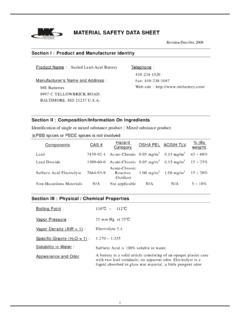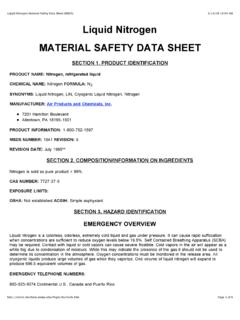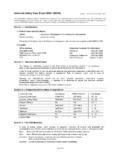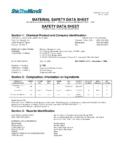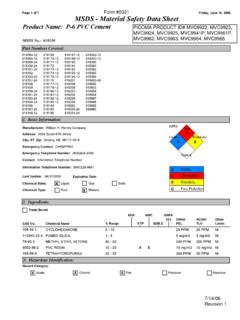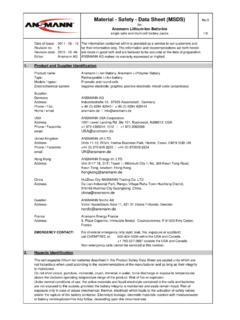Transcription of Material Safety Data Sheet MSDS 2.001
1 Material Safety data Sheet msds Page no.: 1 of 5 Edition: Version: 01 Electronically generated document - no signature required. VARTA Microbattery GmbH Daimlerstra e 1 73479 Ellwangen Germany Fo_175 Lithium Polymer Battery (Series: , ) 1. Identification of the product and of the company undertaking Product details Trade name: Lithium polymer battery Voltage: V (or multiples of this in case of multi-cell configurations) Electrochemical system: Lithium ion Anode (negative): Graphite based Cathode (positive): Lithium cobalt oxide Supplier details Address: VARTA Microbattery GmbH Daimlerstr. 1 D-73479 Ellwangen/Jagst Germany Emergency telephone number: +49-7961-921-211 Legal Remark ( ) Material Safety data Sheets ( msds ) are a sub-requirement of the Occupational Safety and Health Administration (OSHA) Hazard Communication Standard, 29 CFR Subpart This Hazard Communication Standard does not apply to various subcategories including anything defined by OSHA as an "article".
2 OSHA has defined "article" as a manufactured item other than a fluid or particle; (i) which is formed to a specific shape or design during manufacture; (ii) which has end use function(s) dependent in whole or in part upon its shape or design during end use; and (iii) which under normal conditions of use does not release more than very small quantities, minute or trace amounts of a hazardous chemical, and does not pose a physical hazard or health risk to employees. Because all of our batteries are defined as "articles", they are exempted from the requirements of the Hazard Communication Standard. Legal remark (EU) These batteries are no substances or preparations according to Regulation (EC) No 1907/2006 EC. Instead they have to be regarded as articles , no substances are intended to be released during handling. Therefore there is no obligation to supply a msds according to Regulation (EC) 1907/2006, Article 31.
3 General remark This Safety Information is provided as a service to our customers. The details presented are in accordance with our present knowledge and experiences. They are no contractual assurances of product attributes. 2. Hazards identification The battery is sealed hermetically. Thus, the ingredients have no hazard potential, except the battery is violated or dismantled. If in case of mistreatment the ingredients are released, a spontaneously flammable gas mixture may be released under certain circumstances (measures according to chapter 4 to 6). Attention: If batteries are treated wrong the danger of burns or bursts occurs. Batteries must not be heated above 100 C or incinerated. The battery contents must not get in contact with water. If the negative electrode gets in contact with water or humidity hydrogen gas is formed, which may inflame spontaneously. Material Safety data Sheet msds Page no.
4 : 2 of 5 Edition: Version: 01 Electronically generated document - no signature required. VARTA Microbattery GmbH Daimlerstra e 1 73479 Ellwangen Germany Fo_175 3. Composition/information on ingredients Ingredients Contents CAS No. Hazard Symbols R Phrases Material 10 - 30 % 7782-42-5 - - Graphite 20 - 50 % 12190-79-3 Xn R22 - 43 Lithium cobalt oxide 10 - 20 % C R10 - 34 - 40 - 43 Organic electrolyte, consisting of LiPF6 and organic carbonates Heavy Metals Contents CAS No. Material < 1 mg/kg 7440-43-9 Cadmium < 10 mg/kg 7439-92-1 Lead < 0,1 mg/kg 7439-97-6 Mercury Other Ingredients Contents CAS No. Material 6 - 14 % 7440-50-8 Copper 5 - 8 % 7429-90-5 Aluminium 0 - 2 % 7440-02-0 Nickel 2 - 10 % Polymer During charge process a lithium graphite intercalation phase is formed, which is highly flammable (F) and corrosive (C), but not released under the circumstances of normal usage.
5 Hazard Symbols Xn Harmful F Highly flammable C Corrosive R Phrases 10 Flammable 22 Harmful if swallowed 34 Causes burns 40 Limited evidence of a carcinogenic effect 43 May cause sensitization by skin contact. 4. First-aid measures Measures at accidental release After inhalation: Fresh air. Seek for medical assistance. After skin contact: Remove solid particles immediately. Flush affected areas with plenty of water (at least 15 min.). Remove contaminated cloth immediately. Seek for medical assistance. After eye contact: Flush the eye gently with plenty of water (at least 15 min.). Seek for medical assistance. After ingestion: Drink plenty of water. Avoid vomiting. Seek for medical assistance. No trials for neutralization. 5. Fire-fighting measures Suitable extinguishing media: Dry powder is applicable for burning lithium polymer batteries. Metal fire extinction powder, rock salt or dry sand are suitable if only a few batteries are involved.
6 Material Safety data Sheet msds Page no.: 3 of 5 Edition: Version: 01 Electronically generated document - no signature required. VARTA Microbattery GmbH Daimlerstra e 1 73479 Ellwangen Germany Fo_175 Extinguishing media with limited suitability: Carbon dioxide (CO2) and cold water in large volume are only applicable for incipient fire. Do not use warm or hot water. Special protection equipment during fire-fighting: Contamination cloth including breathing apparatus. Special hazard: At contact of electrolyte with water traces of hydrofluoric acid may be formed. In this case avoid contact and take care for good ventilation. At contact of charged anode Material with water extremely flammable hydrogen gas is generated. Attention: Do not let used extinguishing media penetrate into surface water or ground water. If necessary, thicken water or foam with suitable solids.
7 Dispose off properly. 6. Accidental release measures Person related measures: Wear personal protective equipment adapted to the situation (protection gloves, cloth, face protection, breathing protection). Environment protection measures: Bind released ingredients with powder (rock salt, sand). Dispose off according to the local law and rules. Avoid leached substances to penetrate into the earth, canalization or water. Treatment for cleaning: If battery casing is dismantled, small amounts of electrolyte may leak. Package the battery tightly including ingredients together with lime, sand or rock salt. Then clean with water. 7. Handling and storage Always follow the warning information on the batteries and in the manuals of devices. Only use the recommended battery types. Keep batteries away from children. For devices to be used by children, the battery casing should be protected against unauthorized access.
8 Unpacked batteries shall not lie about in bulk. In case of battery change always replace all batteries by new ones of identical type and brand. Do not swallow batteries. Do not throw batteries into water. Do not throw batteries into fire. Avoid deep discharge. Do not short-circuit batteries Guideline for safe handling: Use recommended charging time and current. Storage: Storage preferably at room temperature (approx. 20 C). Avoid large temperature changes. Do not store close to heating devices. Avoid direct sunlight. At higher temperature the electrical performance may be reduced. Preferred storage at 50% of the nominal capacity (OCV ). Storage of unpacked batteries can cause short circuit and heat generation. Storage of large amounts: If possible, store the batteries in original packaging (because of short circuit protection and exemptions according to transport regulations); A fire alarm is recommended; For automatic fire extinction consider chapter 5 Fire fighting measures.
9 VCI storage category: It is recommended to consider the VCI Guideline for the mixed storage of chemicals and to handle lithium polymer batteries according to storage category 11 ( combustible solids ). 8. Exposure controls/personal protection Under normal conditions (during charge and discharge) release of ingredients does not occur. In the event of release of ingredients, the following TLVs have to be considered ( ): Material Safety data Sheet msds Page no.: 4 of 5 Edition: Version: 01 Electronically generated document - no signature required. VARTA Microbattery GmbH Daimlerstra e 1 73479 Ellwangen Germany Fo_175 Material TLV* Cobalt and compounds: mg/m3 (TWA) Graphite: C mg/m3 (TWA) *Source: OSHA CFR 29 Table Z-1, 2 or 3 3-01-2007. 9. Physical and chemical properties Not applicable if closed. 10. Stability and reactivity Dangerous reactions: When heated above 100 C the risk of rupture occurs.
10 11. Toxicological information Under normal conditions (during charge and discharge) release of ingredients does not occur. In case of accidental release see information in chapter 2, 3, 4. 12. Ecological information Lithium batteries do not contain heavy metals as defined by the European directives 2006/66/EC Article 21. 13. Disposal considerations USA: Lithium polymer batteries are classified by the federal government as non-hazardous waste and are safe for disposal in the normal municipal waste stream. These batteries, however, do contain recyclable materials and are accepted for recycling by the Rechargeable Battery Recycling Corporation's (RPBC) Battery Recycling Program. Please go to the RPRC website at for additional information. In the European Union, manufacturing, handling and disposal of batteries is regulated on the basis of the DIRECTIVE 2006/66/EC OF THE EUROPEAN PARLIAMENT AND OF THE COUNCIL of 6 September 2006 on batteries and accumulators and waste batteries and accumulators and repealing Directive 91/157/EEC.
